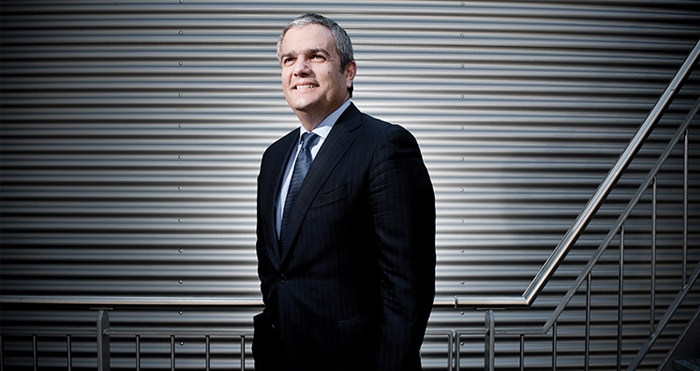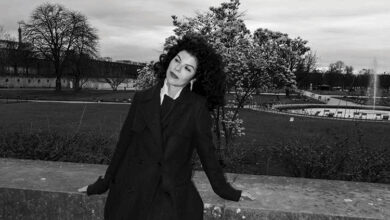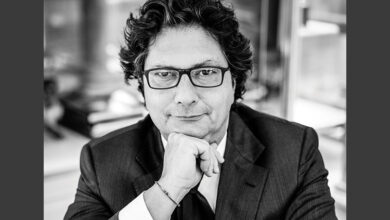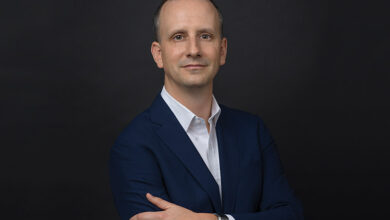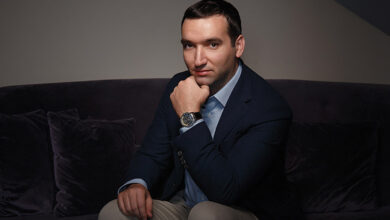Hublot casts its magic on new novelties
Hublot is a Swiss enterprise creating luxury watches since 1980, when it was founded by Italian national, Carlo Crocco. Renowned for its two iconic collections, Classic Fusion and The Big Bang, the brand has gained steady success over the last few years, increasing its collections with an annual selection of novelties. To date, Hublot has around 50 boutiques all over the world
Earlier this year, Day & Night Magazine visited Baselworld in Switzerland, where numerous Swiss watch and jewellery makers gathered to showcase inspiring pieces to enthusiasts from around the world. There, we caught up with the CEO of Hublot, Ricardo Guadalupe, who welcomed us into the brands striking architectural booth that saw a steady flow of customers throughout the multi-story structure. Among the brands strategies, we learnt that Hublot is led by a passionate man who enjoys his role as CEO. Ricardo’s daily routine is not an easy one; long days mean balancing his personal life becomes a challenge as he doesn’t have enough time to share with his son.

How did Hublot become involved in the World Cup?
It was a long and tedious process but we are proud to say that we were the first luxury watch brand to be associated with the exciting sport of football. Being such a popular game, Hublot wanted to reach out to sports enthusiasts and a wider audience of horology connoisseurs, and luckily we got that chance in 2006, when we became the Official Timekeeper for the World Cup that was held in Germany. In 2008, when the Euro Cup came to our home country of Switzerland, we decided to avail the opportunity for more exposure and signed an official contract with UEFA to allow a Swiss Manufacture to be the Official Timekeeper. It was here when we saw the huge potential football has to offer, as the number of visitors to our website greatly increased during this time. From then on we contacted FIFA and proposed our strategy to which they agreed, and only last year in 2014, we changed the course of history, when we officially changed the shape of the board to one that resembles the Big Bang case.
Will Hublot continue to support the World Cup in the future?
The amount of exposure we receive from each World Cup is phenomenal, so yes, definitely we will continue to be present at the World Cup. We have already signed contracts with Russia for 2018, and Qatar, which will host the event in 2022.

Recently Hublot launched the Big Bang Unico Bi-retrograde Chronograph watch that was aimed at football fans. What was the feedback like?
The chronograph watch is specifically made for football fans, but it can be bought by anybody whether or not they like the boisterous sport. The Big Bang Unico is the first Hublot timepiece ever produced with a bi-retrograde function along with a central chronograph dedicated to the top football club; Guangzhou Evergrande Taobao. Hublot wanted to show that with every partnership, there is a dedicated product in the market that reinforces the bond between the two companies. The feedback we received has been positive, customers enjoy wearing a wrist-watch that is aesthetically pleasing as well as maintaining better timekeeping. The best feature the watch demonstrates is the chronograph timing duration of 45 minutes that signal half-time in a football game.
Can you tell us about the collaboration between Hublot and Ferrari?
We have two strong marketing pillars; football and Ferrari that together cover a wide customer base network. The world of football is more mainstream, but the realm of Ferrari demands prestige and refinement that is not available to anybody. We are entering the fourth year of partnership with Ferrari and are delighted with the collaboration we share as Ferrari is well-known all over the world, and by association Hublot gain maximum exposure. For example, in each Ferrari dealership, our clock dominates the wall of the showroom; this could only be achieved if the relationship with each other was based upon trust and respect. Last year we organised around 160 events with Ferrari, which were dotted around the world; some events are done on a smaller scale, whilst others are done on a grander scale with lots of media coverage. A recent example of a small event was in Geneva, where a new car was presented with a Ferrari watch in the window. This event can be compared to a much larger one, where Ferrari marked its 60 year anniversary in the American market. Overall, I am proud of the long-standing professionalism between the two brands and I hope this will continue for the foreseeable future.
What is the process of launching a Ferrari watch? And can we expect another updated version in the future?
There are many steps to launching a watch in collaboration with another brand, however to keep things short, I will keep it simple. Each watch is designed by Hublot – the features, the size, the colours and the position of the logo, however before production can start we need written approval from Ferrari. For example, before the creation of the MP-05 LaFerrari model, we visited Italy with our designers and thought of the concept to put an engine in the watch; obviously we substituted horse-power with an impressive power-reserve of 50 hour. Once preliminary sketches were drawn, we received the go-ahead from Ferrari and proceeded with final draft drawings before moving onto the prototype. With the final 3D product, we sought specific approval of Ferrari, and only then did we launch the Black, Titanium and Gold versions that are currently showcased on our website. Hopefully in the future we will see a new edition of the Ferrari watch, but the process is not an easy one as a lot of time and resources are spent on research and development.
What feedback have you received for The Spirit of Big Bang?
The Spirit of Big Bang is inspired from the Big Bang collection, where it steps away from the traditional shape of the dial to explore new dimensions. Around 90% of watches in the market are of a circular shape, so our timepiece is one of the elite, and we focused on the correct strategy to raise its rank in the market. Our strategy ensured that the timepiece remains exempt from advertising campaigns, enabling it to be a very niche product that adds to its exclusivity and demand, which is resulting in satisfying sales. The Spirit of Big Bang, although selling well, does not add a large percentage to our annual sales – maybe around 5%.
The Big Bang Haute Joaillerie timepiece has an array of exquisite settings. Can you tell us about the timepiece?
This unique timepiece consists of large trapezoid-shaped diamonds that cover the dial and bezel of the watch with an invisible setting. The timepiece holds considerable value due to the quality, size and clarity of the diamonds and also because of the gem setting technique we used to ensure the stones do not fall out. The Big Bang Haute Joaillerie timepiece is the second most expensive watch we have produced, as a few years ago we crafted a 5 million dollar watch that was completely breath-taking. We want to ensure that our jewellery watches remain functional as time keeping devices and not to overburden them with jewels to a point that it loses its purpose.
Where did the inspiration come from for using cigar leaves in The Forbidden X timepiece?
Cigars are one of life’s little luxuries, and our clients are primarily those who enjoy life to the maximum. With our association to the world of sports and racing, we wanted to try something a little different and decided to partner with a company that builds its business on luxury. We met Carlos Fuente, owner of Arturo Fuente cigars, through a mutual friend and with his passion for luxury timepieces and our passion for innovation; we got together and designed the Forbidden X that comes in its very own cigar presentation box.

What is your opinion on the use of Magic Gold?
Together with the The École Polytechnique Fédérale de Lausanne, (EPFL), which is a university specialising in engineering and technology located in Lausanne, Switzerland, Hublot financed a share in the research and development of metallurgy and the resulting material produced was Magic Gold. Magic Gold is formed by combining gold and ceramics in a process that injects the metal with nearly 2.5 times the hardness of standard 18 karat gold. The new material is so strong that it would take a diamond to scratch it, so we are very proud of this feat.
In my opinion, I am thrilled with the development, however it has taken us nearly two years to re-industrialise the material to make a watch. With the use of this material, we need new techniques of fabrication and production as you can’t use regular machines that craft from titanium or steel. We also need high-pressure ovens to set the gold, ultrasonic machines to cut, diamond polishing machines and a whole range of other machinery that is specifically designed for this super hard gold. Currently in our manufacturing laboratory, we are producing a small amount of watches per month – however with the new facility opening, we will increase our production rate as we will have more machinery, so we are estimating to produce over 100 pieces per month with Magic Gold, possibly in a couple of more colours, like red gold.
What are your thoughts on Magic Aluminium?
We did a couple of watches with Magic Aluminium, but we experienced a few technical problems and had to stop working with this material. One of the problems we had was oxidisation, where the colour kept changing to something we did not want. So testing is still under progress, but for now we will stick to more successful materials, like Magic Gold.

What percentage of Hublot’s movements are created in-house?
At the moment the percentage of movements created in-house is around 30%. Our projection is for this figure to rise to over 75% within the next five years, where we can control most aspects of watchmaking under one roof. However the danger in this is that, if a company doesn’t outsource some parts of production, then they become set in a routine and are closed off from suggestions and new ideas. Outsourcing is vital for networking and learning about new techniques within the industry, so as a compromise, Hublot will strive to create in-house movements at 75% at some point in the future, but the remaining 25% will still be outsourced, so we always remain open to communication from the outside.
Hublot use innovative materials. How do you test for longevity of each material?
We have an internal testing department who focus on research and development. 5% of our annual turnover goes into ensuring our materials are of high quality, through many techniques that we employ. We test aging of materials, durability, heat resistance, water resistance among other things.




